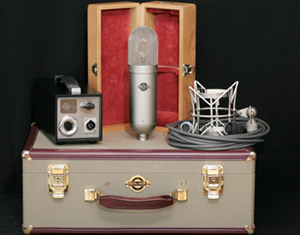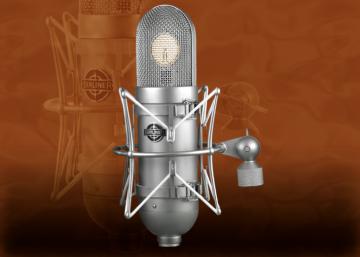The U77 High End Classic Tube Microphone was designed by Berliner Microphones, USA Founder, Dana Kamide. Dana utilized many features from past GERMAN DESIGNS. It is a hand made, point-to-point wired, Tube Microphone utilizing a TRUE German-Made M7 Capsule by Siegfried Thiersch former Neuman Microphone capsule builder and owner of Thiersch Elektroakustik in Schleiz, Germany.
Other parts and accessories for the Berliner U77, also built by hand, come from in surrounding areas of Eastern Europe.
The U77’s tube is a NOS hand tested 5703 Raytheon military lamp with extremely low noise and very long operating life. The parameters are closely related to the legendary AC701K, however the noise floor is a marked improvement over the AC701K. The capsule is our exact replica of the M7 utilizing the Berlin “double ring type” and is built, skinned and tuned by hand in Berlin by our expert German capsule builder.

The transformer is hand wound from military materials and manufactured in small series only. All components utilize point to point wiring and GAC7 microphone cables from Gotham are used as well as German made Sommer cabling.
The PSU is designed with reference to maximum safety and superior performance lending itself to extended tube life. All power components are high-end avoiding the use of any Chinese components.
Included is a solid mahogany box and U47 style shockmount. Each microphone is measured in our lab on Bruel & Kjaer measurement machines and frequency response diagram for each pattern is included with every microphone. Berliner USA is currently designing a custom metal pop screen which will affix directly to the microphone body.
The vintage style carrying case is elegantly designed and built by hand utilizing materials such as 600+ denier nylon, Dupont Cordura®, and high quality brass hardware.
Inside, the mic looks similar to many of the classic mics with hand crafted point-to-point wiring accompanied by two easy to follow circuit boards. Clear Plexiglas dividers separate the diaphragm from the electronics and reinforce the construction of the microphone. The Raytheon NOS 5703 military-grade tube is hard wired due to the power requirements of the tube. This tube is known for its low noise and long life span and is similar to the original M49 tube, the AC701K. The capsule is hand-built and skinned by ex-Neumann engineer Siegfried Thiersch, one of the original builder of the M7 capsule. The U77 is built exactly the way he built the original M7 — the Berlin double ring type — with the exception of using Mylar instead of PVC, which deteriorates over time and is subject to environmental conditions such as heat or moisture. [According to the manufacturer, PVC components are one of the reasons why the original M7 sounded slightly different from one another — Ed.]

Even the U77’s case was designed with excellence in mind; it utilizes 600 and higher denier nylon, DuPont Cordura, highest quality ?to ?-inch plywood, high-quality vinyl, polyester and leather with complete protection against humidity and other elements. Although I was not brave enough to try, it is claimed that the case can be fully immersed in water without the mic even getting damp.
In Use
My first test for the U77 was a female vocal on a song that ranged from low and raspy to high and, if not careful, ear piercing high-mids. I tried a few other low to mid-priced condenser microphones on this particular vocal and each time I was fighting to calm down the sonics. The signal chain was the U77 to a Summit 2BA-221 dialed completely into the solid state circuitry followed by a dbx 160XT compressor set to just barely grab the loudest points of the vocal.
After listening to a dry run, it was decided that no external EQ was necessary. The intimacy in the lower part was beautifully captured with the U77. Proximity really exposed the vulnerability the singer was imparting when the pop filter was 1 and ?-inches away from the microphone. The true test was when the belting started in the higher ranges. The U77’s character really shone as what are usually offensive frequencies were naturally smoothed out; not dulled in any way, but more like the harshness was rounded off.
This was also the result with a male singer with more of a baritone/alto range; the mic was superb in capturing the performance while naturally rounding out what are often troubled frequencies without the assistance of equalization.
The mic was lent to another engineer to use on some overdubs consisting of banjo, acoustic guitar and violin. The basic signal path included the U77 into a combination of mic pres from API and Millennia, a dbx 160 for compression and, occasionally, the A-Designs Hammer HM2EQ tube EQ for added coloration to taste. Regardless of the chain, the results were excellent in each instance. So far, the U77 was really proving itself to be a great mic to have on hand for all applications. A testament to that was the violinist — a mainstay in the Nashville recording community — had such high affection for the results that he inquired about how he may acquire a U77 for his personal collection. This unsolicited endorsement spoke highly of the microphone capturing the body and fullness of the violin.
Summary
From Dan Wothke, Pro Sound News:
Like all microphones, the Berliner U77 has a character and color all its own. Whether or not it sounds like the M7 capsule is up for debate as I have heard M7 capsules and many other vintage mics that don’t sound like each other due to age and wear. The selling fact for this microphone is I would not hesitate to line it up with its vintage and modern counterparts in a shootout to find the best microphone for the desired result. For a facility where only one high-end tube microphone is an option to have on hand, the U77 is a admirable choice that would not disappoint as the primary go-to mic. In the “put your money where your mouth” is department, that is just what we did at our studio: we made the U77 our primary microphone for spoken word, vocals and a plethora of instrumentation — and have not once regretted the decision.

